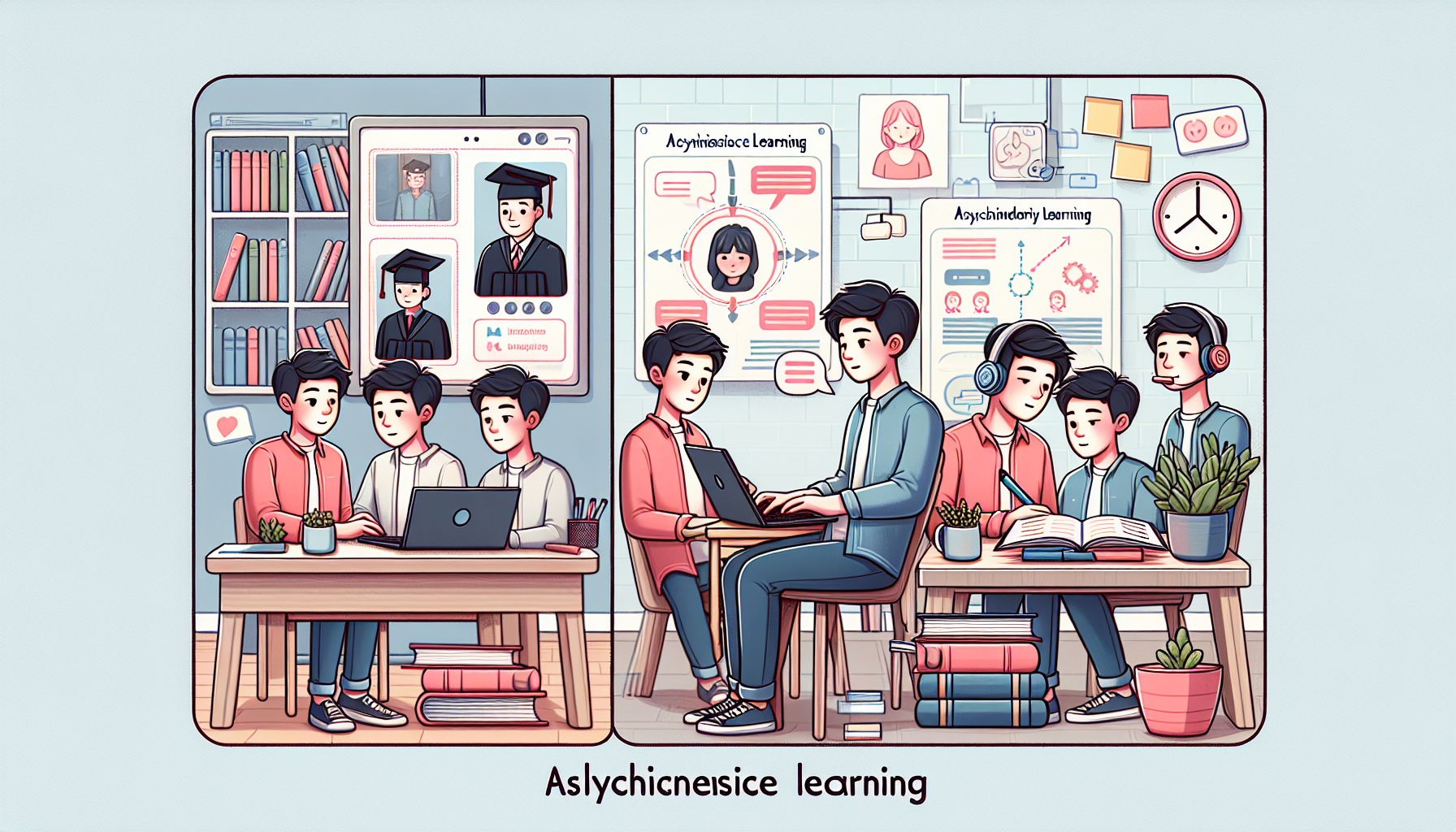It can be confusing to choose between synchronous and asynchronous learning. You might be wondering which one fits your lifestyle better or whether one is more effective than the other. You’re not alone—many people have the same questions when diving into modern education options.
If you stick around, I promise you’ll discover the key differences between these two styles, along with their unique perks and challenges. By the end, you’ll have a clearer picture of which approach might work best for you and your learning goals.
We’ll explore each type, highlight their benefits and challenges, and even touch on blended learning methods that incorporate both. So, let’s get started on this educational journey!
Key Takeaways
- Synchronous learning happens in real-time with immediate feedback and lively discussions.
- Asynchronous learning allows flexible schedules and personal pacing for better understanding.
- Synchronous learning creates a stronger community feeling, while asynchronous encourages deeper reflection.
- Both methods have benefits and challenges that depend on personal preferences and life commitments.
- Time management and self-discipline are vital for success in asynchronous learning.
- Students in synchronous classes may feel rushed or overlooked if they’re less vocal.
- Asynchronous learning offers a pressure-free environment, especially for shy learners.

Synchronous Learning Explained
Synchronous learning refers to a type of educational experience where students and instructors interact in real-time.
This approach typically utilizes tools like video conferencing, live chat, or collaborative software, allowing participants to engage simultaneously.
Think of it as being in a classroom where everyone is present at the same time, whether it’s physically or virtually.
For instance, platforms like Zoom or Microsoft Teams enable educators to conduct live lectures, facilitating immediate feedback and discussions.
One of the main advantages of this format is the opportunity for instant clarification of doubts and the dynamic nature of discussions.
Plus, it helps create a sense of community among learners, which can be especially valuable in online settings.
Asynchronous Learning Explained
Asynchronous learning, on the other hand, allows students to engage with course materials at their own pace, on their own schedule.
This model fosters independence and caters to individual learning styles, as students can revisit lectures and resources whenever they choose.
Typical examples include pre-recorded lectures, discussion boards, and assignments submitted online.
Many online courses utilize platforms like Moodle or Canvas to facilitate this learning method.
The biggest perk? Students can accommodate their learning around their other commitments, making education more accessible for many.
However, it does require self-discipline and time management skills to stay on track.
Key Differences Between Synchronous and Asynchronous Learning
So, what’s the big difference between these two methods of learning?
First off, in synchronous learning, everyone is learning together in real-time, whereas asynchronous allows for flexibility to learn at your own pace.
In terms of interaction, synchronous learning tends to have more immediate communication, while asynchronous learning may lead to delayed responses.
Moreover, synchronous formats can foster a stronger community feeling due to shared real-time experiences, while asynchronous formats often allow deeper individual reflection.
Deciding between the two usually hinges on personal learning preferences and logistical constraints.
Benefits of Synchronous Learning
There are several benefits to synchronous learning that are worth considering.
First and foremost is the immediate feedback students receive, which can enhance understanding and engagement.
Real-time interaction with instructors and peers promotes a sense of belonging and can keep students motivated.
Additionally, synchronous classes often lead to more lively discussions, where ideas can be exchanged and explored on-the-spot.
Communication skills also get a boost as students practice articulating their thoughts in real-time.
For those who thrive on structure, this learning environment can help keep everyone accountable and on track with course content.

Benefits of Asynchronous Learning
Asynchronous learning comes with its fair share of benefits that can make it an attractive option for many students.
One major advantage is the flexibility it offers, allowing learners to study whenever it suits them, which can be a lifesaver for those juggling work or family commitments.
This flexibility not only accommodates various schedules but also caters to different learning speeds, enabling students to take their time and thoroughly understand the material.
Students can revisit challenging topics through recorded lectures, promoting a deeper retention of information.
In addition, asynchronous learning often cultivates a more thoughtful discussion environment, as students have time to reflect on their responses before posting in discussion forums.
For those who may feel shy or anxious in real-time interactions, this format provides a pressure-free space to express their thoughts and ideas.
Moreover, asynchronous courses may often be more diverse and widely accessible, giving learners access to materials and instructors from all around the globe.
Challenges of Synchronous Learning
While synchronous learning has many benefits, it also presents several challenges that should be considered.
One of the primary issues is scheduling; coordinating a time for everyone to meet can be tough, especially in diverse time zones.
If a student misses a class, catching up can be more difficult since the lessons aren’t usually available for later review.
Additionally, the reliance on technology means that technical difficulties can disrupt the flow of learning, causing frustration for both students and instructors.
This format may also favor those who are more extroverted or speaking-focused, leaving quieter students feeling overlooked in discussions.
It’s crucial for educators to be aware of these challenges and create inclusive strategies that engage every learner effectively.
By ensuring that all participants can contribute, synchronous learning can strive to be more equitable.
Challenges of Asynchronous Learning
Just like synchronous learning, asynchronous learning isn’t without its hurdles.
A key challenge is the potential for isolation; students may feel disconnected from their peers and instructors due to the lack of real-time interaction.
This can lead to decreased motivation and engagement, especially for those who thrive in supportive, interactive environments.
Self-discipline becomes essential in asynchronous courses, as the absence of live classes can make it easier to procrastinate.
Without regular check-ins, students may struggle to stay accountable for their progress, which could affect their performance.
Additionally, the volume of available resources can be overwhelming, making it challenging to sift through materials and find what’s relevant.
To combat these issues, students might consider creating a structured study schedule and taking advantage of online communities or discussion boards to stay connected with peers.

Which Learning Style is Right for You?
Choosing the right learning style really depends on your personal preferences, lifestyle, and individual needs.
To find out what suits you better, think about your past experiences with learning.
If you thrive in structured environments and enjoy spontaneous discussions, synchronous learning might be your jam.
On the flip side, if you prefer flexibility and like to digest information at your own pace, you may find asynchronous learning more beneficial.
A good approach is to experiment with both styles.
Try attending a few synchronous sessions and see how you feel.
Then, switch it up by enrolling in an asynchronous course to contrast the experiences.
Ultimately, a blended approach can also work well, combining the best of both worlds.
Take your time, reflect on your learning habits, and choose the method that empowers you.
Examples of Synchronous and Asynchronous Learning
Examples of synchronous learning include live lectures, workshops, and interactive webinars.
For instance, university classes held on platforms like Zoom or Google Meet where students and instructors engage in discussions in real-time.
Similarly, virtual study groups or live Q&A sessions can enhance the learning process by allowing for immediate feedback and engagement.
As for asynchronous learning, think about pre-recorded lecture videos you can watch at any time, or discussion forums where you can post your thoughts whenever you want.
Platforms like Coursera and Udemy exemplify this approach, providing students with a variety of courses they can complete at their own pace.
In addition, online quizzes and assignments submitted through a learning management system (LMS) are classic examples of asynchronous tasks.
These methods are designed to fit into your schedule, giving you the chance to learn when it’s most convenient for you.
The Future of Learning: Blended Approaches
The future of education is not just about choosing one format over another.
It’s leaning towards blended learning, which combines the strengths of both synchronous and asynchronous methods.
This approach allows flexibility while also keeping a semblance of community through real-time interactions.
For example, imagine taking an online course where you can watch pre-recorded lectures at your leisure, but also have scheduled live sessions for Q&A with instructors and peers.
This hybrid model caters to different learning styles and lifestyles, making education more accessible and engaging.
As technology continues to evolve, the incorporation of AI, virtual reality, and interactive tools will further revolutionize how we learn.
Looking forward, it’s exciting to see how blended learning will open doors for personalized and inclusive education experiences.
FAQs
Synchronous learning involves real-time online classes or meetings where instructors and students interact simultaneously, often facilitated by video conferencing platforms. This format fosters immediate feedback and engagement.
Asynchronous learning offers flexibility, allowing students to access materials and complete assignments on their own schedule. This format promotes self-paced learning and accommodates diverse learning styles and individual commitments.
Challenges of synchronous learning include scheduling difficulties, technical issues, and the potential for less personalized attention in larger classes. Additionally, participants often require stable internet connections for effective engagement.
Choosing between synchronous and asynchronous learning depends on your schedule, learning style, and the need for interaction. Consider factors such as flexibility, the importance of real-time feedback, and your self-discipline.
